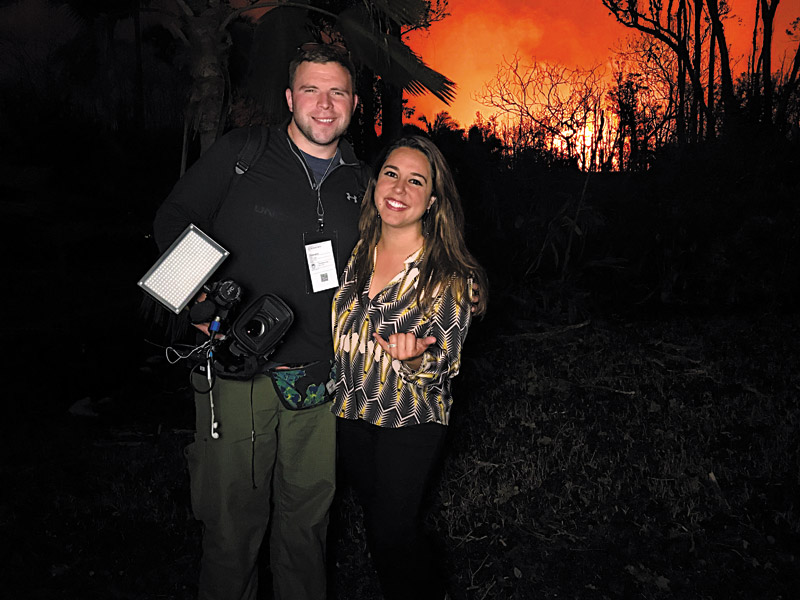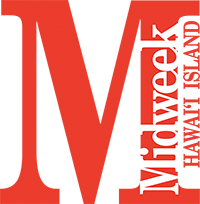There’s No Place Like Home

Mileka Lincoln’s (third from right) family consists of (from left) Kūmanō Lincoln Maielua (nephew), Keali‘i Maielua (brother-in-law), Keakamahana Lincoln Maielua (nephew), Pualani Lincoln Maielua (sister), ‘Ahu‘ula Lincoln Maielua (nephew), and Luana (mom) and Alika Lincoln (dad)
Life as a TV reporter may have forced Mileka Lincoln to establish her professional news career elsewhere, but the Big Island will always have a special place in her heart.
Hunkered down in Lower Puna for nine straight weeks during the Kīlauea eruption last year, Hawai‘i News Now reporter Mileka Lincoln was the source for reliable breaking news about events on the ground as they unfolded in real time.
In stark contrast to the often sensationalized, erroneous reporting by national news outlets, Lincoln’s fact-based daily dispatches from Pāhoa provided residents with the accurate information they needed during the ever-changing disaster.
Even though she had a front-row seat for dramatic sights like towering lava fountains, booming fissure eruptions and fast-moving lava rivers, the real story for Lincoln was how the community rallied together to help one another when the government could not or would not.

Lincoln stayed with Tehani and Hulali Kekuawela and their family while handling the ongoing eruption coverage. She met the ‘ohana while covering the P˛hoa lava threat in 2014.
“A supplies and donations center popped up called Pu‘uhonua O Puna that epitomized the spirit of the community,” she says. “It became a hub for emotional support, too. I was so humbled to be with these volunteers who walked away from their jobs to be in service of others. To see people who’d lost their homes but were still offering their pickup trucks to help others. They made a real impression on my heart.”
In the more than two months she covered the eruption, Lincoln only left Puna for a scant few days: twice to Waimea, where she was born and raised and where her family resides, and three times to O‘ahu, where she is based full time.
It just so happened that the day before the most destructive event of the eruption, Lincoln was in Waimea to celebrate father Alika Lincoln’s birthday. When it became clear that the massive lava flow from Fissure 8 was headed directly for Kapoho Bay, photographer Andrew Hara urged her to come back and join him on a helicopter flight. She was able to bring her father.

This photo marks Lincoln’s ˝ rst time back to Hawai‘i Volcanoes National Park after it was closed to the public following signi˝ cant damage.
“We flew above Kapoho before it was taken out by lava,” she recalls. “I remember the countless times my dad and I had swam in the tide pools. I heard him say goodbye and we held hands. It was the first time I cried throughout the whole eruption. The very next day it was gone. I was on the ground when I got the call. Kapoho was beloved by so many.”
Lincoln grew up with her family in Kūhiō Village, a state Department of Hawaiian Home Lands neighborhood. Her father was a firefighter for 30 years with Waimea Fire Station and also served in combat in Vietnam. Her mother, Luana Lincoln, was a secretary at Hawai‘i Preparatory Academy and currently works at Isaacs Art Center. Her sister, Pualani Lincoln Maielua, is a teacher on the Upper Campus.
After graduating from HPA in 2002, Lincoln attended USC on a scholarship as a broadcast journalism major. Her interest in the profession began when she was glued to the television watching wall-to-wall coverage of 9/11.
“I was drawn to the fact that there were journalists on the ground committed to keeping people informed and safe,” she says. “I remember thinking this is the kind of impactful journalism that can help people in times of need.”

Lincoln spends time with Merlin, whom she helped rescue from Pohoiki Boat Ramp. PHOTOS COURTESY MILEKA LINCOLN
During college, Lincoln came home every summer to intern at KHON2 News. After graduating from USC’s Annenberg School for Journalism in 2006, she spent another six years on the mainland working for various affiliates, first landing a fellowship with the Los Angeles bureau of ABC News, and also serving as a production assistant on a special report with Diane Sawyer. Her first on-camera gig took place in Laredo, Texas, where she covered the border for eight months. She then worked for four years at a FOX affiliate in San Antonio before relocating to Austin.
“In Austin, we launched a new morning show with the CBS affiliate there. I was there, barely one year into a three-year contract, and I just wanted to be home. I had a tugging on my piko. I bought a one-way ticket home on Christmas Eve in 2012. Everything in this business is about timing — and I had the opportunity to come home. I was so unbelievably excited to work for an organization like Hawai‘i News Now. But even though I was back in Hawai‘i, albeit on O‘ahu, home will always be Hawai‘i Island.”
Although she was working full time in Honolulu for Hawai‘i News Now, little did she know that she would end up covering so many amazing stories on the Big Island.
Her first big assignment was the Merrie Monarch Festival in 2013.
“I danced hula my whole life, but to cover it is like a dream I never realized I had,” she says.

Lincoln covers the lava damage at Leilani Estates. JOHN TARSON PHOTO
When Hurricane Iselle devastated parts of Lower Puna in 2014, and lava threatened the town of Pāhoa that same year, Lincoln witnessed the resiliency and generosity of the people of Puna. She soon became a treasured member of the community.
“I’m happy to be adopted by the Puna ‘ohana,” she says. “It’s a district that is misunderstood, even by people from Hawai‘i Island. No matter the neighborhood, people in Puna have been so unbelievably kind and generous. During Hurricane Iselle, for example, we were working around the clock getting very little sleep. Folks watching the broadcast would recognize a home or intersection we were at, and come with food and water or even bring a pop-up tent where we were standing outside in the pouring rain. They have a very special way of showing aloha in Puna.”
During the eruption, Lincoln also witnessed the power of social media, and how average citizens became the eyes and ears all over the community via Facebook Live or Instagram Live. All the rules of news dissemination got thrown out the window, for better or worse, she adds.

Lincoln and Hawai‘i News Now photographer Casey Lund pose for a picture.
PHOTO COURTESY MILEKA LINCOLN
“Everyone with a smart-phone became a source of information. It was a chance to use that for the power of good, because there was so much uncertainty with how quickly the lava was moving.”
For Lincoln, there’s no place like home to have a career in broadcast journalism. She says she is always taken aback when someone asks her when she is going to move on to something “bigger and better” in her profession.
“There is nothing bigger and better than this for me,” she says. “There is nothing more meaningful than being at home. I feel the responsibility to provide compassionate, accurate, thorough and well-intentioned reporting. During the eruption, I was there to do the job, but then the community shows up for you in a big way with its support, whether food, a popup tent or a place to stay. It becomes a beautiful circle. I was there on behalf of every other resident or global resident. I wear my heart on my sleeve for my community.”

